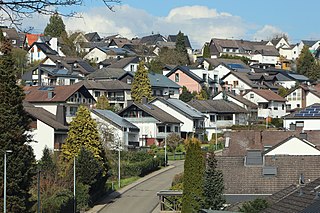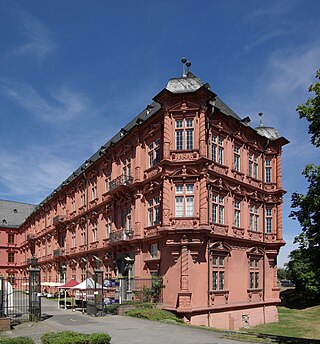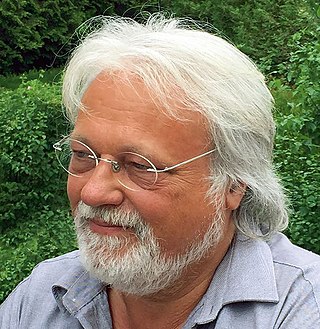Life and work
From 1972 to 1977, Monika Kropshofer studied first Law at the Johannes Gutenberg-University in Mainz. After her two years as an articled clerk in Mainz, she worked as a lawyer from 1980, first in Mainz, then in Koblenz, and took her doctorate in 1982. In 1983, Kropshofer opened her own law office and was active as a court lawyer at the Coblence High Court of Justice. She terminated this activity in 1990 to study the History of art at the Rheinische Friedrich-Wilhelms-Universität Bonn. At the same time, she worked as a freelance artist, finishing her studies in 1995. [1]
Kropshofer began her autodidactic artistic training by experimenting with various picture material and bases. From the beginning, she turned her main attention to the combination of various media, especially photography and painting. Kropshofer projects landscape and architecture photographs [2] onto the most varied kinds of bases (glass, sheets of plastic, photographic paper, window blinds, plastic foils) and subsequently works on them with paint. [3] [4] [5] Here, Kropshofer does without any additional digital picture processing. [6] [7] The photographs are taken during the artist's regular working trips and stays in Europe, Africa and South-East Asia. [8] Since the mid-2000s, the works have become larger in format and more far-reaching and from now on, extensive installations [9] and objects were also created.
Kropshofer's artistic discussion always turns around the formal dialogue between the object depicted and the media used. [10] Her method for doing this is the construction and deconstruction of spatiality, depending on each picture basis and the revelation of the appropriateness of the structures in landscape and architecture with the help of painting. Thus her works are in the tradition of photography's very own discourse, the question of reproduction and reality, fiction and real life. [11] [12] [13] [14] [15]
The artist lives and works in Boppard. [16]

Rhineland-Palatinate is a western state of Germany. It covers 19,846 km2 (7,663 sq mi) and has about 4.05 million residents. It is the ninth largest and sixth most populous of the sixteen states. Mainz is the capital and largest city. Other cities are Ludwigshafen am Rhein, Koblenz, Trier, Kaiserslautern, Worms, and Neuwied. It is bordered by North Rhine-Westphalia, Saarland, Baden-Württemberg and Hesse and by France, Luxembourg and Belgium.

Linz am Rhein is a municipality in the district of Neuwied, in Rhineland-Palatinate, Germany. It is situated on the right bank of the river Rhine near Remagen, approx. 25 km southeast of Bonn and has about 6,000 inhabitants. It is the sister city of Marietta, Georgia in the United States, Linz in Austria and Pornic in France.

Neustadt an der Weinstraße, formerly known as Neustadt an der Haardt, is a town in Rhineland-Palatinate, Germany. With 53,300 inhabitants as of 2020, it is the largest town called Neustadt.

Budenheim is a municipality in the Mainz-Bingen district in Rhineland-Palatinate, Germany. Unlike other municipalities in Mainz-Bingen, it does not belong to any Verbandsgemeinde.

Middle Rhine is the section of the Rhine between Bingen and Bonn in Germany. It flows through the Rhine Gorge, a formation created by erosion, which happened at about the same rate as an uplift in the region, leaving the river at about its original level, and the surrounding lands raised. This gorge is quite deep, about 130 metres (430 ft) from the top of the rocks down to the average water-line.

Bad Hönningen is a municipality in the district of Neuwied, in Rhineland-Palatinate, Germany. It is situated on the right bank of the Rhine, approx. 15 km (10 mi) northwest of Neuwied, and 30 km (20 mi) southeast of Bonn.
The University of Koblenz and Landau was a German public university located in Koblenz and Landau, Rhineland-Palatinate, which primarily focused on teacher education.

Boppard Hauptbahnhof is a station in the town of Boppard in the German state of Rhineland-Palatinate. It is located on the outskirts of the town near the Rhine. It is at a railway junction on the West Rhine Railway between Köln Hauptbahnhof and Mainz Hauptbahnhof, and it is the starting point of the Hunsrück Railway (Hunsrückbahn) to Emmelshausen. It has three platform tracks.

Ehlscheid is a municipality in the district of Neuwied, in Rhineland-Palatinate, Germany. Part of the municipality are also three Wohnplätze, namely Forsthaus Gommerscheid, Hof Talblick and Talhof. (Forsthaus may be translated as forester's lodge, Hof as homestead).

Melsbach is a municipality in the district of Neuwied, in Rhineland-Palatinate, Germany. Since 2018, it is part of the Verbandsgemeinde Rengsdorf-Waldbreitbach.

Ober-Hilbersheim is an Ortsgemeinde – a municipality belonging to a Verbandsgemeinde, a kind of collective municipality – in the Mainz-Bingen district in Rhineland-Palatinate, Germany.

Neuwied station is, along with Engers station, a hub of public transport in the town of Neuwied in the German state of Rhineland-Palatinate and it is located in its west. The station is located on the East Rhine Railway and is the starting point of the Neuwied–Koblenz railway. In the station forecourt there is a bus station. The station is classified by Deutsche Bahn as a category 3 station.

The Römisch-Germanisches Zentralmuseum (RGZM), Leibniz Research Institute for Archaeology, is headquartered in Mainz. It is supported by the Federal Republic of Germany and its states and is a member of the Leibniz Association of German research institutions.

Michael Ebling is a German politician of the Social Democratic Party (SPD) who served as State Minister of the Interior in the government of Minister-President Malu Dreyer of Rhineland-Palatinate since 2022. From 2012 to 2022, he was the mayor of Mainz.

Monrepos is an archaeological research centre and a museum of human behavioural evolution located at Schloss Monrepos in Neuwied. The development of our modern human behaviour in the Palaeolithic and Mesolithic is studied at the research centre and the findings of these studies are conveyed to the public in the museum. Monrepos is one of the leading institutions for the research of early human history.

Michael Post is a German painter, Object artist and curator. He is an exponent of concrete art.
Rüdiger Sterzenbach is a German economist and transportation scientist, sports official, CDU politician and a representative of a family of entrepreneurs. He was professor for economics and passenger transport management at Heilbronn University of Applied Sciences, former president of the regional sports federation of Rhineland-Palatinate "Landessportbund Rheinland-Pfalz", chairman of the regional sports foundation of Rhineland-Palatinate "Sporthilfe Rheinland-Pfalz/Saarland" and economic policy spokesman for the CDU Rhineland-Palatinate. His father was a factory worker, his mother was a housewife. He is married and has two grown sons.

Wolfgang Maria Ohlhäuser is a German painter.

Heinz Schwarz was a German politician of the Christian Democratic Union of Germany (CDU) who was a long-time member of the state parliament of Rhineland-Palatinate, serving as the state's minister of the interior. From 1976 to 1990, he was a member of the Bundestag.
















